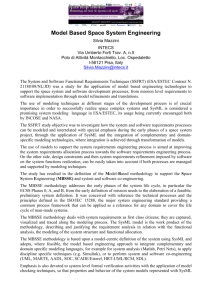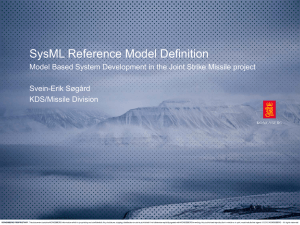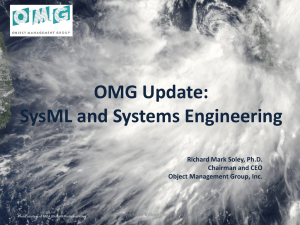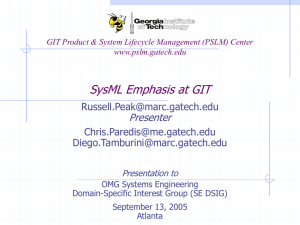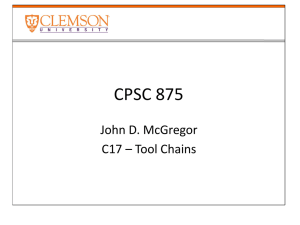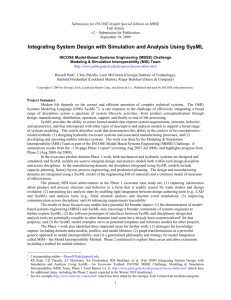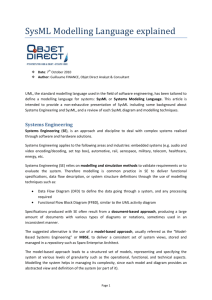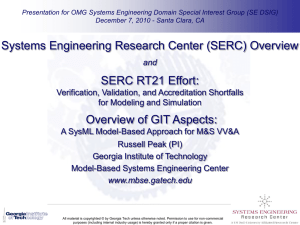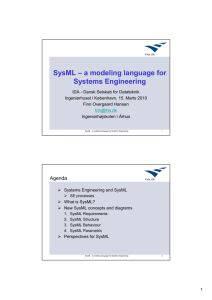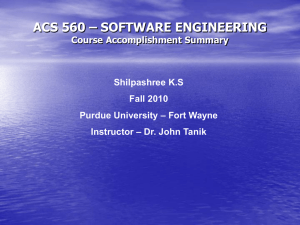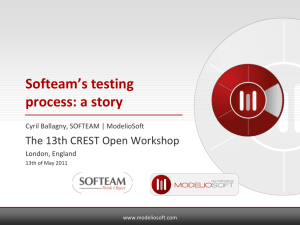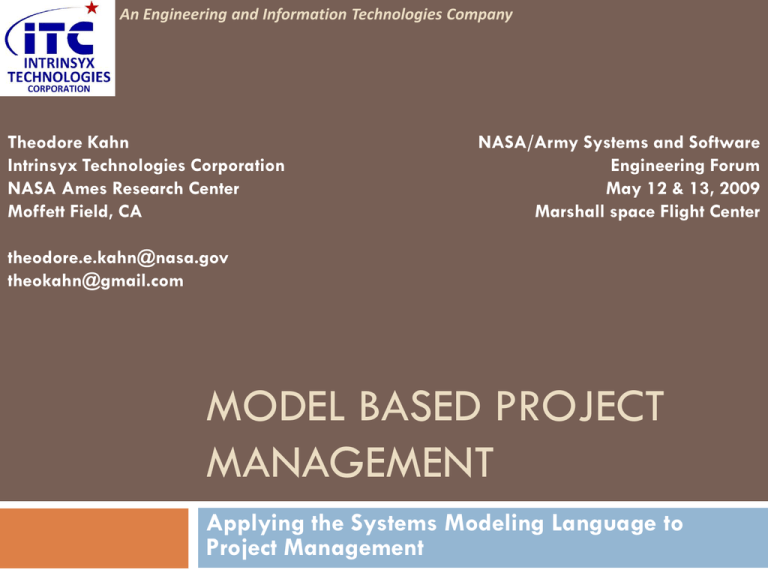
An Engineering and Information Technologies Company
Theodore Kahn
Intrinsyx Technologies Corporation
NASA Ames Research Center
Moffett Field, CA
NASA/Army Systems and Software
Engineering Forum
May 12 & 13, 2009
Marshall space Flight Center
theodore.e.kahn@nasa.gov
theokahn@gmail.com
MODEL BASED PROJECT
MANAGEMENT
Applying the Systems Modeling Language to
Project Management
Problem statement
2
Project and system information is now document
centric:
Relies
on textual, tabular, and graphic documents from a
variety of sources which means…
interpretation of the information is difficult and consistency
hard to maintain, especially under changing conditions.
Model centric approach relies far less on documents:
Depends
instead on a single repository for storing project
structural and behavioral information…
Promotes a more common interpretation and consistency of
project information, even under very dynamic conditions.
Ted Kahn theokahn@gmail.com
Presentation objectives
3
Provide a conceptual understanding of modeling as it
might be applied to project management and system
engineering.
Enable you to make informed decisions regarding its
applicability to your situation.
The talk does not address implementation issues or methodology,
though those would be interesting areas for the discussion at the end.
4
Presentation overview
Some basic SysML semantics
Theoretical aspects of modeling
Demonstration of a SysML tool and
models
Q & A, and discussion
5
Conclusion
6
Why you don’t want to model
Why you do want to model
Modeling is hard
Modeling tools are difficult
Modeling will likely require cultural changes
It increases the rate of communications
It increases the precision of communications
It reduces tacit information
It promotes a common understanding of your project
Benefit: Stakeholders having a common understanding of
how the project is organized and its objectives will work
together more effectively and make better decisions.
7
Theoretical aspects of modeling
SysML and project management
Modeling in the context of SysML
SysML structure and semantics
Conclusion
8
Relationship between project
management and systems engineering
While project management and systems
engineering share many of the same qualities,
there are important differences.
Similarities between PM & SE
9
Lots of behaviors having complex
relationships
Lots of entities having complex
relationships
Many relationships and dependences
between behaviors and entities.
Systems engineering
10
Systems engineering is a multidisciplinary approach
for developing balanced systems solutions in
response to diverse stakeholder needs.
It includes the application of both management and
technical processes to achieve balance and mitigate
project risk.
The management process is applied to ensure that
development cost, schedule and technical
performance objectives are met.
Source: A Practical Guide to SysML., copyright © 2008 by Elsevier, Inc. All rights reserved.
Differences between PM & SE
11
Attribute
Project Management
Systems Engineering
Scheduling
Absolute times
Relative times
Economic cost
Mandatory/aggregation centric Optional/unit centric
People
Individuals and roles
Role centric
Entities and
behaviors
Notional
Precise
Project Management Models
12
Gantt, PERT
Charts
Temporal Models
Informs
SysML
Structural
Models
Informs
Behavioral
Models
Being a successful PM or SE means:
13
Understanding the project/system information and
how it fits together.
Communicating and otherwise making this
information available to stakeholders in a timely,
consistent fashion in a form relevant to their
backgrounds and needs.
14
Part II, SysML
SysML and project management
Modeling in the context of SysML
SysML structure and semantics
Summary
SysML modeling is about communications
15
It’s a language having syntax and structure…
that uses a medium, primarily graphics…
and has a methodology, which currently is largely
undefined.
Three main attributes of languages
16
Abstractions of the world around us
Some form of persistence
A shared experience: a producer and a consumer
Three main attributes of SysML
17
Abstractions of systems
Database persistence
A shared experience
Model, model on the wall…
18
who’s the truest of us all:
An electrical schematic of a radio
An economic model
A model student
A non working model airplane
A novel about present day life the author believes
to be possible
A description of a pencil
SysML and other modeling constructs
19
Abstraction
More
Concepts
Enterprise
architectures
SysML
Less
Domain
specific
languages
Examples
DoDAF,
MoDAF,
UPDM, FEA
SysML
UML, Modelica,
Simulink,
MARTE
Abstraction levels
20
La Joconde
Femme au Chapeau Orné
Two criticisms of SysML...
21
Its old ideas warmed over – Abstractions and
persistence have been around at least since humans
drew pictures on cave walls. There is nothing new
here.
Its simply not practical – Having my team think
abstractly in the same way and put their
information into a database in the same fashion is
absurd. It is not workable.
A historical perspective
22
23
Part II, SysML
SysML and project management
Modeling in the context of SysML
SysML structure and semantics
Summary
SysML Diagram Taxonomy
24
Source: OMG Specification
Model elements
25
Models consist of elements
Elements must have unique names, within a
namespace
All model elements must reside in (be owned by)
one package
Major types of model elements
26
Structural
Behavioral
Packages
27
Models are composed of one or more packages
Packages can contain other packages and/or any
collection of model elements
Package hierarchies define the name space
Packages shown as a containment tree
28
Source: A Practical Guide to SysML., copyright © 2008 by Elsevier, Inc. All rights reserved.
Packages shown graphically
29
Source: A Practical Guide to SysML., copyright © 2008 by Elsevier, Inc. All rights reserved.
Dependences and stereotypes
30
Source: A Practical Guide to SysML., copyright © 2008 by Elsevier, Inc. All rights reserved.
Blocks
31
Blocks represent structural elements
Organizations
Data
People
Airplanes
Blocks have two main attributes
Properties,
other structural elements
Behavior, either as an intrinsic capability or through
behavioral elements
Block property types
32
Parts (in UML, composition)
References (in UML, aggregation)
Associations
Block definition diagram—Part
33
The black diamond is
used for communicating a
Part Property relationship
Source: OMG Specification
Block definition diagram—Association
34
No adornment is used for
communicating an Association
Property relationship
Source: OMG Specification
Block definition diagram—Reference
35
The white diamond is
used for communicating a
Reference Property
relationship
Source: A Practical Guide to SysML., copyright © 2008 by Elsevier, Inc. All rights reserved.
Block compartments
36
Source: A Practical Guide to SysML., copyright © 2008 by Elsevier, Inc. All rights reserved.
Blocks and inheritance
37
Source: A Practical Guide to SysML., copyright © 2008 by Elsevier, Inc. All rights reserved.
Activity Diagrams
38
Sample activity diagram 2
39
Source: A Practical Guide to SysML., copyright © 2008 by Elsevier, Inc. All rights reserved.
40
Requirement diagram—Purpose
41
Fully and unambiguously specify what the model is
to do (functional requirements) and the context in
which it is to operate (non-functional requirements).
Provide concise and unambiguous information
showing how requirements relate to each other.
Provide concise and unambiguous information
showing how requirements relate to other model
elements—the project lifecycle.
Requirements diagram—Example
42
Source: A Practical Guide to SysML., copyright © 2008 by Elsevier, Inc. All rights reserved.
Requirements dependences
43
«refine»
«satisfy»
«deriveReqt»
«copy»
«verify»
«trace»
Refine, satisfy & dervieReqt
44
Source: OMG Specification
Copy
45
Source: OMG Specification
Verify
46
Source: A Practical Guide to SysML., copyright © 2008 by Elsevier, Inc. All rights reserved.
Trace
47
Source: A Practical Guide to SysML., copyright © 2008 by Elsevier, Inc. All rights reserved.
Use case scope
48
Use cases and actors
49
Actors are external entities that interact with your
system via use cases
Actors can be people, computer systems or really
any device that interacts with your system.
It is high recommended that Actors be modeled
before use cases.
Actors for a household model
50
Use cases for household food processes
51
52
Part II, SysML
SysML and project management
Modeling in the context of SysML
SysML structure and semantics
Summary
Key SysML features & capabilities
53
Open standard
Works equally well with structural and behavioral
artifacts
Treats requirements as first-class modeling elements
Future plans include simulations
Formal mechanism for extending SysML semantics
Formal set of semantically consistent graphical
elements.
54
Source: OMG Specification
SysML requirements relationships
55
Conclusion
56
Why you don’t want to model
Why you do want to model
Modeling is hard
Modeling tools are difficult
Modeling will likely require cultural changes
It increases the rate of communications
It increases the precision of communications
It reduces tacit information
It promotes a common understanding of your project
Benefit: Stakeholders having a common understanding of
how the project is organized and its objectives will work
together more effectively and make better decisions.
57
Demonstration
An ad hoc initial attempt at modeling the NASA
Constellation program, manned moon/Mars mission.
The notions and ideas expressed in these slides
represent my own interpretations and have not been
vetted or sanctioned by NASA in any way. They are
presented solely for educational purposes regarding
how large engineering projects might be rendered in
a SysML model.
Model Organization
58
59
Generic Mission Template
60
Integrated Vehicle Engineering Analysis
61
Constellation Data Taxonomy
62
63
Backup
Relationship between UML and SysML
64
Source: OMG Specification
UML/SysML metamodel
65
Source: OMG Specification
Copyright Information
66
OMG Source material is reprinted with permission. Object Management
Group, Inc. (C) OMG. 1997 - 2006.

